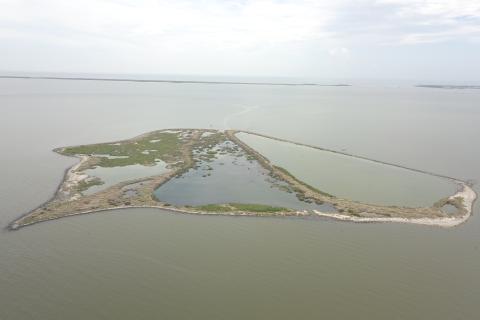The Louisiana Trustee Implementation Group’s efforts to restore Queen Bess Island were lauded recently when state officials celebrated the 50th anniversary of the reintroduction of the state bird, the brown pelican, to the Louisiana coast.
Although not widely known, the Pelican State lost all of its brown pelicans for about a decade in the 1960’s.
Prior to that, in the early 1900’s Louisiana’s brown pelican population was estimated at 50,000 to 80,000. By 1963, however, the use of the chemical DDT took a huge toll on many bird species, including the brown pelican. Sadly, the bird was no longer found in the state except on the flag.
Louisiana and Florida biologists joined forces beginning in 1968 to reintroduce the bird to coastal Louisiana. Over the next eight years, more than 760 brown pelican chicks were relocated to coastal Louisiana. In 1971, 11 nests were documented on Queen Bess, marking the first successful recolonization of brown pelicans in Louisiana.
Biologists kept track of the growing numbers and documented a peak of about 4,000 nests on Queen Bess in 2008.
Marking the 50th anniversary of the reintroduction, Louisiana Department of Wildlife and Fisheries Secretary Jack Montoucet said, “To think that we almost lost our state bird, the brown pelican, is almost inconceivable.”
Now, with the pelicans relying on the island for precious nesting habitat, biologists have turned their sights on saving the island from the erosion that has reduced it to a fraction of its former size. Because pelicans and their habitat were badly injured by the Deepwater Horizon oil spill, Natural Resource Damage settlement funds paid by BP are being used to evaluate engineering and design options for restoration of Queen Bess Island.
In January 2017, the Louisiana Trustee Implementation group approved its first post-settlement restoration plan. The plan included $2.5 million in engineering and design funding for restoration of Queen Bess Island. That work is currently underway and will provide a design for the restoration of 29 acres of brown pelican and wading bird habitat, 7 acres of nesting tern and black skimmer habitat and breakwaters on the southwestern perimeter of the island in a future restoration plan. “Supporting larger numbers of these nesting birds in this area is all about providing and maintaining the right habitat”, explained John Tirpak, U.S. Fish and Wildlife Service biologist.
If construction funding is approved, the restoration project could begin as early as September 2019 and could be completed by February 2020. Regarding the future of Queen Bess and the pelicans Montoucet explained, “The job now is to make certain the species continues to flourish. We look forward to working with our partners to ensure that happens.”
Louisiana’s Coastal Protection and Restoration Authority is working with LDWF and USFWS to develop plans to rebuild Queen Bess to its original 36-acre footprint. “The State is will soon request from our fellow TIG members approval of a plan and funding to construct the entirety of this project, which will restore habitat for and encourage the pelican repopulation in Louisiana for a long time to come,” stated Johnny Bradberry, CPRA Board Chairman and Executive Assistant to the Louisiana Governor for Coastal Activities.
See more photos of Queen Bess Island and its brown pelicans.


